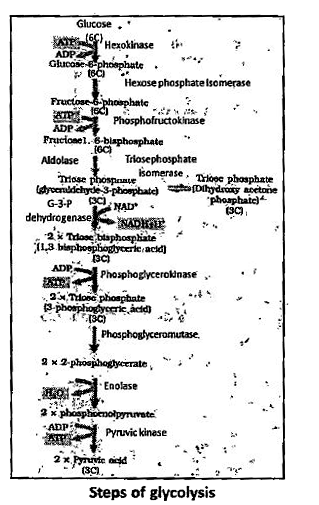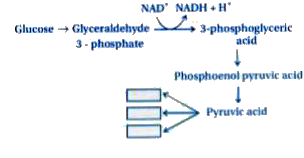Give an account of glycolysis, Where does it occur ? What are the end products? Trace the fate of these products in both aerobic, and anaerobic respiration. Solution in Telugu
Glycolysis occurs in the cytoplasm. The end product of glycolysis is pyruvic acid.
Glycolysis is the process in which glucose undergoes partial oxidation to form two molecules of pyruvic acid. It is as follows.
1) in the first of glycolysis, a phosphate group is added to glucose molecule in the formation of glucose-6-phosphate. ATP is, utilised. This reaction is catalysed by hexokinase enzyme.
Glucose + ATP hexokinase−−−−−→ Glucose-6-phosphate + ADP
2) Phosphohexokinase enzyme catalyses the conversion of glucose-6-phosphate to its-isomer fructose-6-phosphate.
Glucose-6-phosphate phosphohexose isomerase−−−−−−−−−−−−−−→ Fructose 6-phosphate
3) Fructose-6-phosphate undergoes phosphorylation resulting Fructose-1,6 bisphosphate. In this step ATP is utilised. This reaction is done by enzyme phosphofructokinase.
Fructose-6-phosphate + ATP Phosphofructokinase−−−−−−−−−−−→ ructose1-6 bisphosphate + ADP
4) Fructose. 1-6 bisphosphate with the help of enzyme aldolase splits into 2 molecules. They are glyceraldehyde 3 phosphate and dihydroxyacetone phosphate (DHA Fructose-1,6 bisphosphate Aldolase−−−−→ Glyceraldehyde-3 phosphate + Dihydroxyacetone phosphate
5) Among the two trioses, only Glyceraldehyde 3 phosphate directly participates in the subsequent reaction.s.
On the other hand, dihydroxyacetone phosphate gets converted into glyceraldehyde-3-phosphate in the presence of triose phosphate isomerase and can participate in the next reaction of glycolysis.
Dihydroxyacetone phosphate, Triose phosphate isomerase−−−−−−−−−−−−−−−→ Glyceraldehyde-3-phosphate.
6) Glyceraldehyde-3-phosphate undergoes oxidation as well as phosphorylation in the presence of glyceraldehyde 3 phosphate dehychoganase resulting in the formation of 1-3 bisphospho glyceric acid and NADH.
Glyceraldehyde-3-phosphate + NAD+
Glyceraldehyde-3-phosphate dehydrogenase −−−−−−−−−−−−−−−−−−−−−−−−−−→ 1,3 bisphosphoglyceric acid + NADH + H+
7) Phosphoglycerokinase enzyme catalyses the dephosphorylation of 1,3 bisphosphoglyceric acid resulting in the formation of 3 phosphoglyceric acid. ADP molecule.accepts the phosphate released in this reaction and gets converted into high energy. compound ATP. This process of formation is known as substrate level phosphorylation.
1,3 bisphosphoglyceric acid + ADP+iP Phosphoglycerokinase −−−−−−−−−−−−−→ 3 Phosphoglyceric acid + ATP
8) Phosphoglyceromutase enzyme catalyses the transfer of phosphate group from 3-carbon.position of 3 PGA to 2-carbon: position leading to the formation of 2PGA.
3 PGA Phosphoglyceromutase−−−−−−−−−−−−−→ 2 PGA
9) The enzyme enolase catalyses the removal of one water molecule from 2-phospho- glyceric acid resulting in the formation of phosphoenol pyruvic acid.
2 phosphoglyceric acid Enolase−−−→ Phosphoenol pyruvic acid +H2O
10) Phosphoenol pyruvic acid undergoes dephosphorylation in the presence of the enzyme pyruvic, kinase and results in the formation of pyruvic acid. ADP is converted to ATP. This is substrate level of phosphorylation.
Phosphoerol pyruvic acid (PEP) + ADP Pyruvic kinase−−−−−−−−→ Pyruvic acid + ATP
Fate of Pyruvic acid : The ultimate fate of pyruvic acid which is an end product of glycolysis depends upon the availability of oxygen. In the presence of oxygen it is completely oxidized into CO2 and H2O If oxygen is not available, the pyruvic acid is converted to ethyl alcohol or other organic substances by fermentation during anaerohir roeninntion .

Topper's Solved these Questions
Similar Questions
Transpiration is necessary evil. Explain?
03:31View SolutionExplain the reactions of Kreb's cycle.
04:00View SolutionGive an account of glycolysis, Where does it occur ? What are the end products? Trace the fate of these products in both aerobic, and anaerobic respiration.
View SolutionGiven an account of glycolysis. Where does it occur? What are the end products? Trace the fate of these products in both aerobic and anaerobic respiration.
02:18View SolutionGiven an account of Glycolysis. Where does it occur ? What are the end products ? Trace the fate of these products in both aerobic and anaerobic respiration .
View Solution(a) What are the end products in anaerobic respiration ? How much energy is released in it ? Is it considered wasteful process ? (b) Does anaerobic respiration occur in aerobes ? Give example .
02:11View SolutionWhat are the end products of Aerobic and Anaerobic Respirations?
03:40View SolutionPyruvic acid is the end product of glycolysis. What are the three metabolic fates of pyruvic acid under aerobic and anaerobic conditions ?
01:30View SolutionName the end products of aerobic and anaerobic glycolysis. List the two ways by which molecules of ATP are produced in glycolysis during aerobic respiration in a cell.
02:23View SolutionWhere does glycolysis occur ? What is the end product of glycolysis ?
02:54View SolutionWhat are the end products of aerobic and anaerobic respiration ?
06:29View SolutionPyruvic acid is the end product of glycolysis. What are the three metabolic fates of pyruvic acid under aerobic and anaerobic conditions? Write in the space provided in the diagram.
04:14View SolutionGiven an account of glycolysis. Where does it occur? What are the end products? Trace the fate of these products in both aerobic and anaerobic respiration.
02:25View SolutionPyruvic acid is the end product of glycolysis. What are the three metabolic fates of pyruvic acid under aerobic and anaerobic conditions ? Write in the space provided in the diagram
 01:22View Solution
01:22View SolutionPyruvic acid, the key/end product of glycolysis has many metabolic fates. What does it form under aerobic condition?
02:18View SolutionPyruvic acid is the end product of glycolysis, what are the three metabolic fates of pyruvic acid under aerobic and anaerobic conditions? Write in the space provided in the diagram.
View Solution

